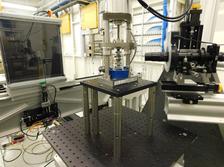Schematic layout of EH3
The experimental hutch EH3 is is dedicated to experiments with small to medium sized sample environments using combinations of various measurement techniques. The main techniques available in EH3 are diffraction, WAXS, SAXS, and imaging.
At the beginning of the EH3 an about 3 m long table accommodates optical elements (e.g. slits and CRLs).
Next, rails on the floor provide convenient positioning of diffractometers. At the moment, only the inferface diffractometer can be used. The hallmark of the interface diffractometer is the stable and precise inclination of a vertical rotation axis against the beam to accommodate grazing incidence geometries. Above the rotation axis a cross tilt and xyz-stages enable sample alignment. A maximum load of about 200 kg will be supported. A bulk diffractometer is planned, but not yet available. It will feature a precise and fast air-bearing rotation stage with vertical rotation axis. Loads of a few hundred kg are envisioned. Above the rotation axis a xyz-stage will be available for sample positioning. In addition to electrical slip rings an open through whole should enable supply of liquids and gases during rotation.
Currently, two detector portals are installed on rails downstream of the diffractometers for convenient and simultaneous coverage of reciprocal space regions. Portal 1 is intended for detectors centered on the beam and can approach the sample position to about 300 mm without modification. Portal 2 also enables horizontal detector translation perpendicular to the beam of about 2.5 m. Both portals can be independently translated along the beam by about 3 m.
For future, another portal (portal 3) is planned at about 6 m behind the sample, which is intended for high-resolution reciprocal space mapping.
Finally, about 15 m downstream of the sample a SAXS detector is positioned behind an about 8 m long permanent flight tube.







